2003 LEXUS LS430 reset
[x] Cancel search: resetPage 2426 of 4500
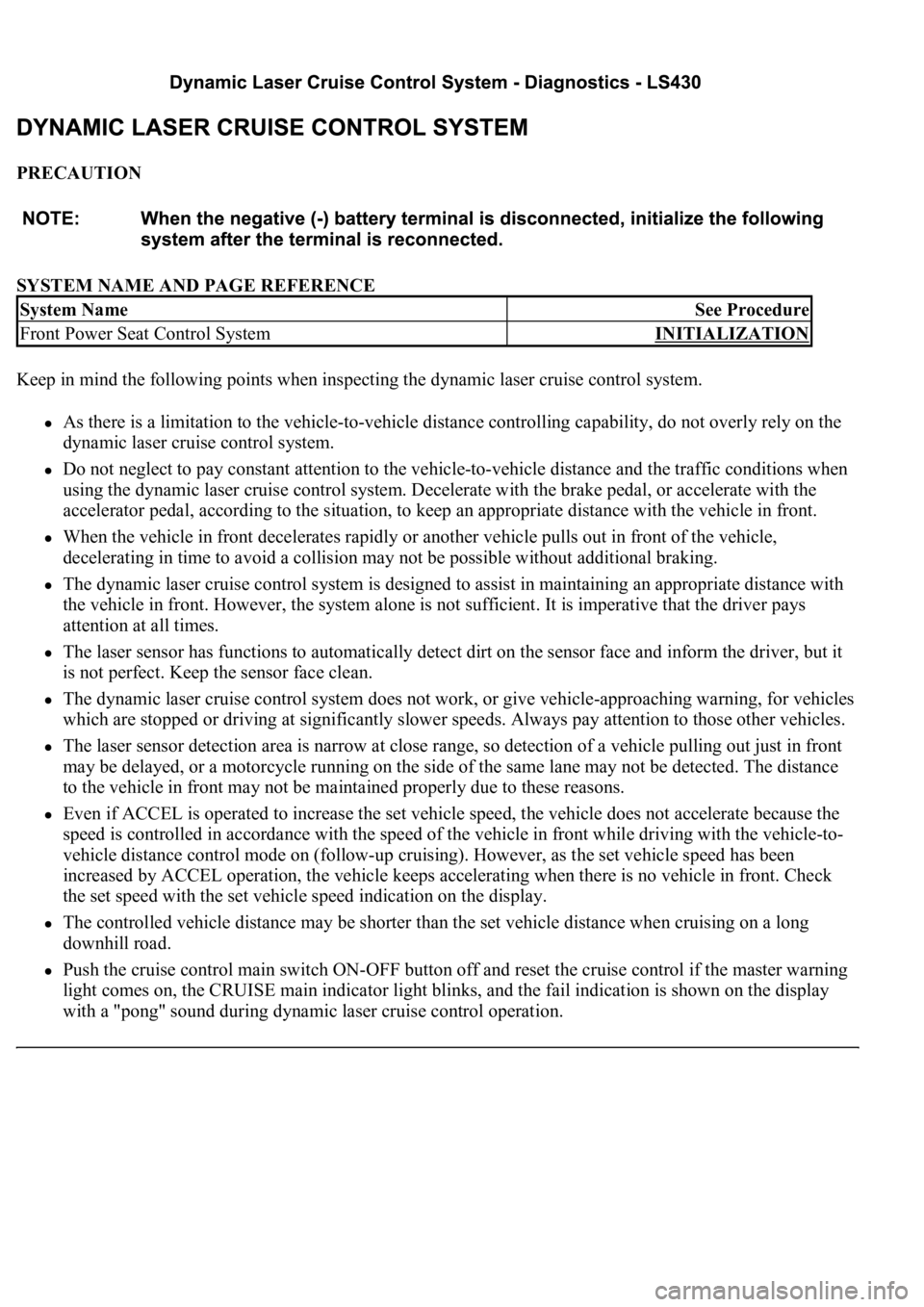
PRECAUTION
SYSTEM NAME AND PAGE REFERENCE
Keep in mind the following points when inspecting the dynamic laser cruise control system.
As there is a limitation to the vehicle-to-vehicle distance controlling capability, do not overly rely on the
dynamic laser cruise control system.
Do not neglect to pay constant attention to the vehicle-to-vehicle distance and the traffic conditions when
using the dynamic laser cruise control system. Decelerate with the brake pedal, or accelerate with the
accelerator pedal, according to the situation, to keep an appropriate distance with the vehicle in front.
When the vehicle in front decelerates rapidly or another vehicle pulls out in front of the vehicle,
decelerating in time to avoid a collision may not be possible without additional braking.
The dynamic laser cruise control system is designed to assist in maintaining an appropriate distance with
the vehicle in front. However, the system alone is not sufficient. It is imperative that the driver pays
attention at all times.
The laser sensor has functions to automatically detect dirt on the sensor face and inform the driver, but it
is not perfect. Keep the sensor face clean.
The dynamic laser cruise control system does not work, or give vehicle-approaching warning, for vehicles
which are stopped or driving at significantly slower speeds. Always pay attention to those other vehicles.
The laser sensor detection area is narrow at close range, so detection of a vehicle pulling out just in front
may be delayed, or a motorcycle running on the side of the same lane may not be detected. The distance
to the vehicle in front may not be maintained properly due to these reasons.
Even if ACCEL is operated to increase the set vehicle speed, the vehicle does not accelerate because the
speed is controlled in accordance with the speed of the vehicle in front while driving with the vehicle-to-
vehicle distance control mode on (follow-up cruising). However, as the set vehicle speed has been
increased by ACCEL operation, the vehicle keeps accelerating when there is no vehicle in front. Check
the set speed with the set vehicle speed indication on the display.
The controlled vehicle distance may be shorter than the set vehicle distance when cruising on a long
downhill road.
Push the cruise control main switch ON-OFF button off and reset the cruise control if the master warning
light comes on, the CRUISE main indicator light blinks, and the fail indication is shown on the display
with a "pong" sound during dynamic laser cruise control operation.
System NameSee Procedure
Front Power Seat Control SystemINITIALIZATION
Page 2444 of 4500
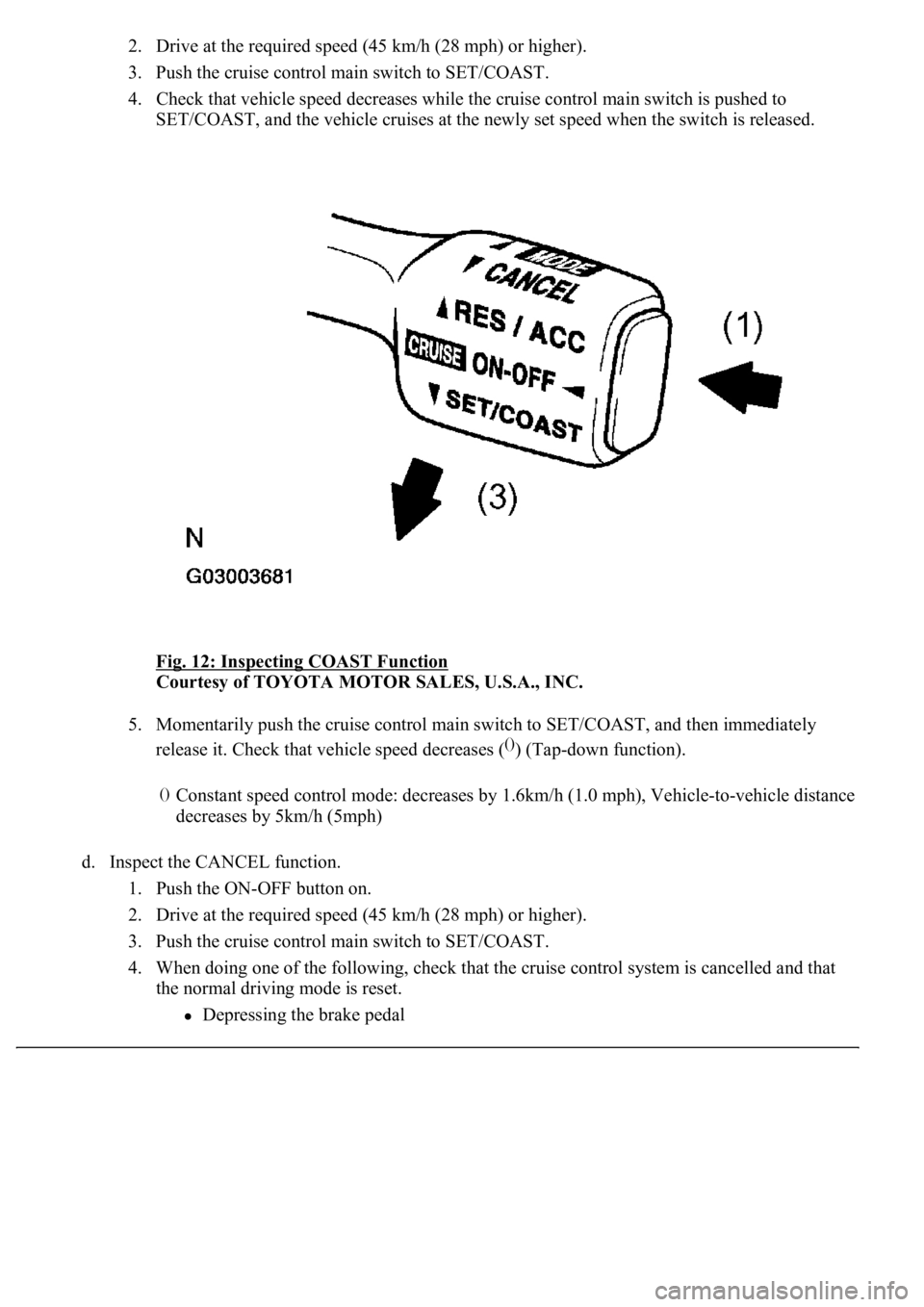
2. Drive at the required speed (45 km/h (28 mph) or higher).
3. Push the cruise control main switch to SET/COAST.
4. Check that vehicle speed decreases while the cruise control main switch is pushed to
SET/COAST, and the vehicle cruises at the newly set speed when the switch is released.
Fig. 12: Inspecting COAST Function
Courtesy of TOYOTA MOTOR SALES, U.S.A., INC.
5. Momentarily push the cruise control main switch to SET/COAST, and then immediately
release it. Check that vehicle speed decreases (
()) (Tap-down function).
d. Inspect the CANCEL function.
1. Push the ON-OFF button on.
2. Drive at the required speed (45 km/h (28 mph) or higher).
3. Push the cruise control main switch to SET/COAST.
4. When doing one of the following, check that the cruise control system is cancelled and that
the normal driving mode is reset.
Depressing the brake pedal
()Constant speed control mode: decreases by 1.6km/h (1.0 mph), Vehicle-to-vehicle distance
decreases by 5km/h (5mph)
Page 2445 of 4500
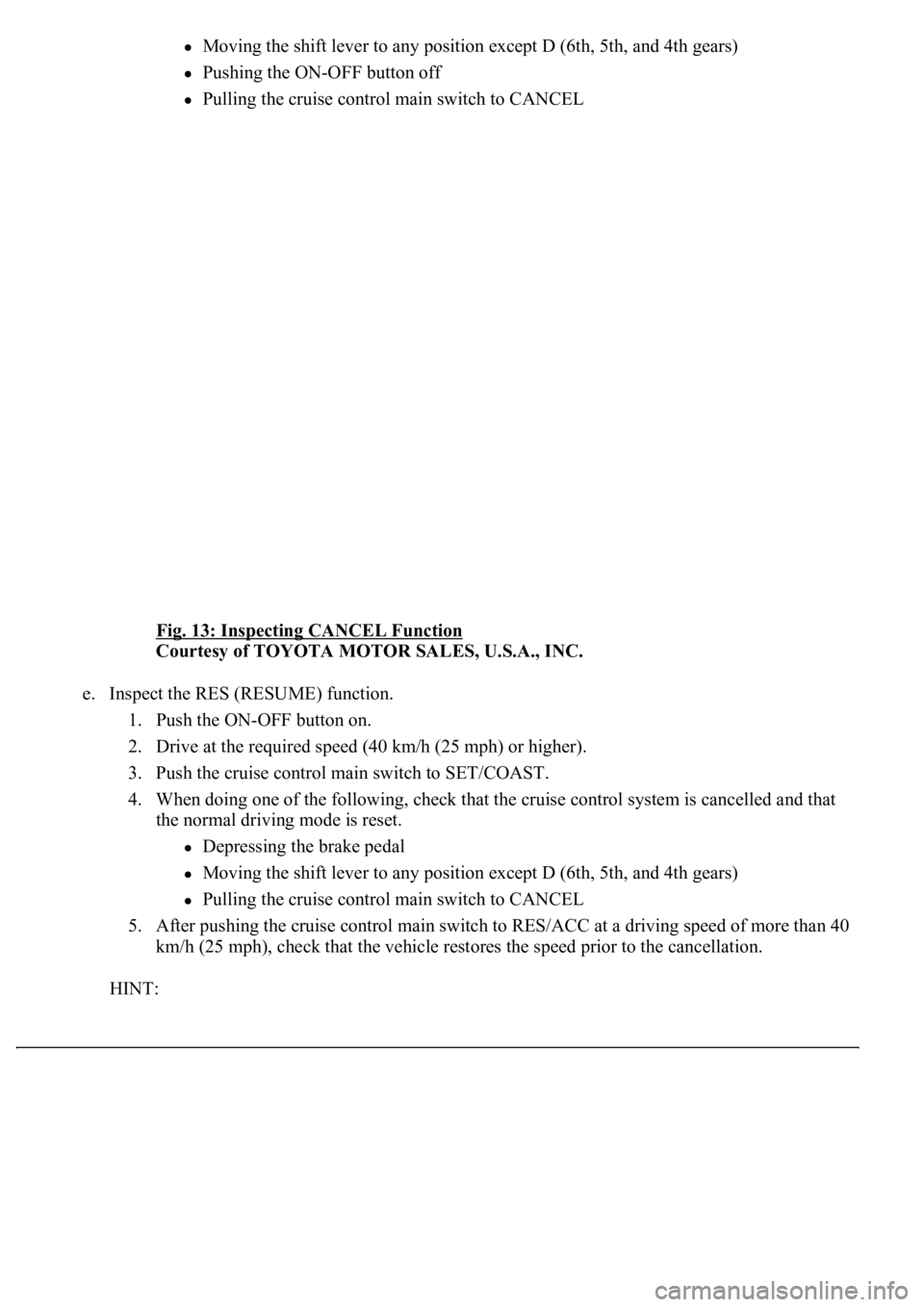
<003000520059004c0051004a00030057004b004800030056004b004c004900570003004f0048005900480055000300570052000300440051005c0003005300520056004c0057004c0052005100030048005b0046004800530057000300270003000b001900
57004b000f000300180057004b000f00030044005100470003[4th gears)
Pushing the ON-OFF button off
Pulling the cruise control main switch to CANCEL
Fig. 13: Inspecting CANCEL Function
Courtesy of TOYOTA MOTOR SALES, U.S.A., INC.
e. Inspect the RES (RESUME) function.
1. Push the ON-OFF button on.
2. Drive at the required speed (40 km/h (25 mph) or higher).
3. Push the cruise control main switch to SET/COAST.
4. When doing one of the following, check that the cruise control system is cancelled and that
the normal driving mode is reset.
Depressing the brake pedal
<003000520059004c0051004a00030057004b004800030056004b004c004900570003004f0048005900480055000300570052000300440051005c0003005300520056004c0057004c0052005100030048005b0046004800530057000300270003000b001900
57004b000f000300180057004b000f00030044005100470003[4th gears)
Pulling the cruise control main switch to CANCEL
5. After pushing the cruise control main switch to RES/ACC at a driving speed of more than 40
km/h (25 mph), check that the vehicle restores the speed prior to the cancellation.
HINT:
Page 2526 of 4500
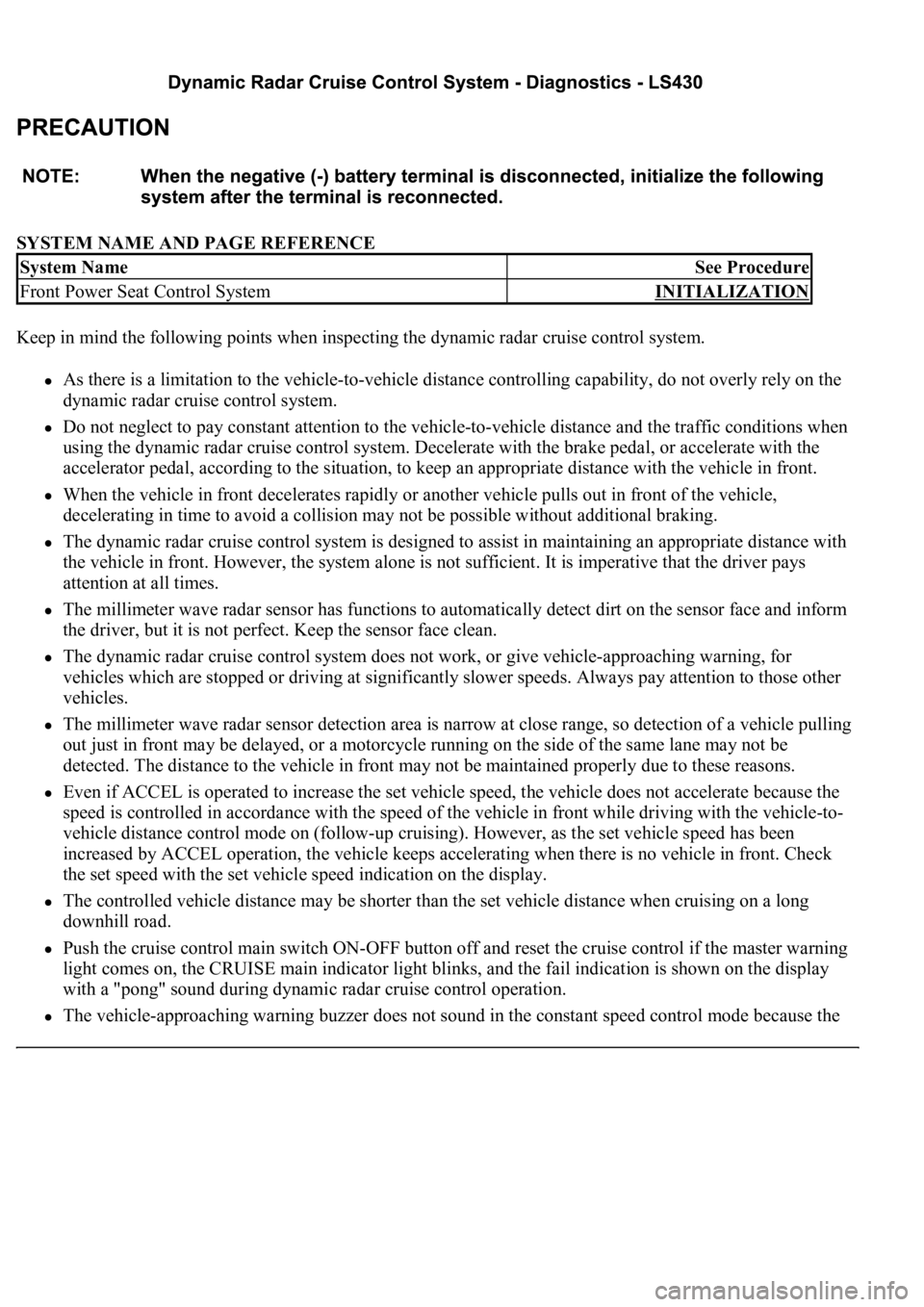
SYSTEM NAME AND PAGE REFERENCE
Keep in mind the following points when inspecting the dynamic radar cruise control system.
As there is a limitation to the vehicle-to-vehicle distance controlling capability, do not overly rely on the
dynamic radar cruise control system.
Do not neglect to pay constant attention to the vehicle-to-vehicle distance and the traffic conditions when
using the dynamic radar cruise control system. Decelerate with the brake pedal, or accelerate with the
accelerator pedal, according to the situation, to keep an appropriate distance with the vehicle in front.
When the vehicle in front decelerates rapidly or another vehicle pulls out in front of the vehicle,
decelerating in time to avoid a collision may not be possible without additional braking.
The dynamic radar cruise control system is designed to assist in maintaining an appropriate distance with
the vehicle in front. However, the system alone is not sufficient. It is imperative that the driver pays
attention at all times.
The millimeter wave radar sensor has functions to automatically detect dirt on the sensor face and inform
the driver, but it is not perfect. Keep the sensor face clean.
The dynamic radar cruise control system does not work, or give vehicle-approaching warning, for
vehicles which are stopped or driving at significantly slower speeds. Always pay attention to those other
vehicles.
The millimeter wave radar sensor detection area is narrow at close range, so detection of a vehicle pulling
out just in front may be delayed, or a motorcycle running on the side of the same lane may not be
detected. The distance to the vehicle in front may not be maintained properly due to these reasons.
Even if ACCEL is operated to increase the set vehicle speed, the vehicle does not accelerate because the
speed is controlled in accordance with the speed of the vehicle in front while driving with the vehicle-to-
vehicle distance control mode on (follow-up cruising). However, as the set vehicle speed has been
increased by ACCEL operation, the vehicle keeps accelerating when there is no vehicle in front. Check
the set speed with the set vehicle speed indication on the display.
The controlled vehicle distance may be shorter than the set vehicle distance when cruising on a long
downhill road.
Push the cruise control main switch ON-OFF button off and reset the cruise control if the master warning
light comes on, the CRUISE main indicator light blinks, and the fail indication is shown on the display
with a "pong" sound during dynamic radar cruise control operation.
The vehicle-approaching warning buzzer does not sound in the constant speed control mode because the
System NameSee Procedure
Front Power Seat Control SystemINITIALIZATION
Page 2544 of 4500
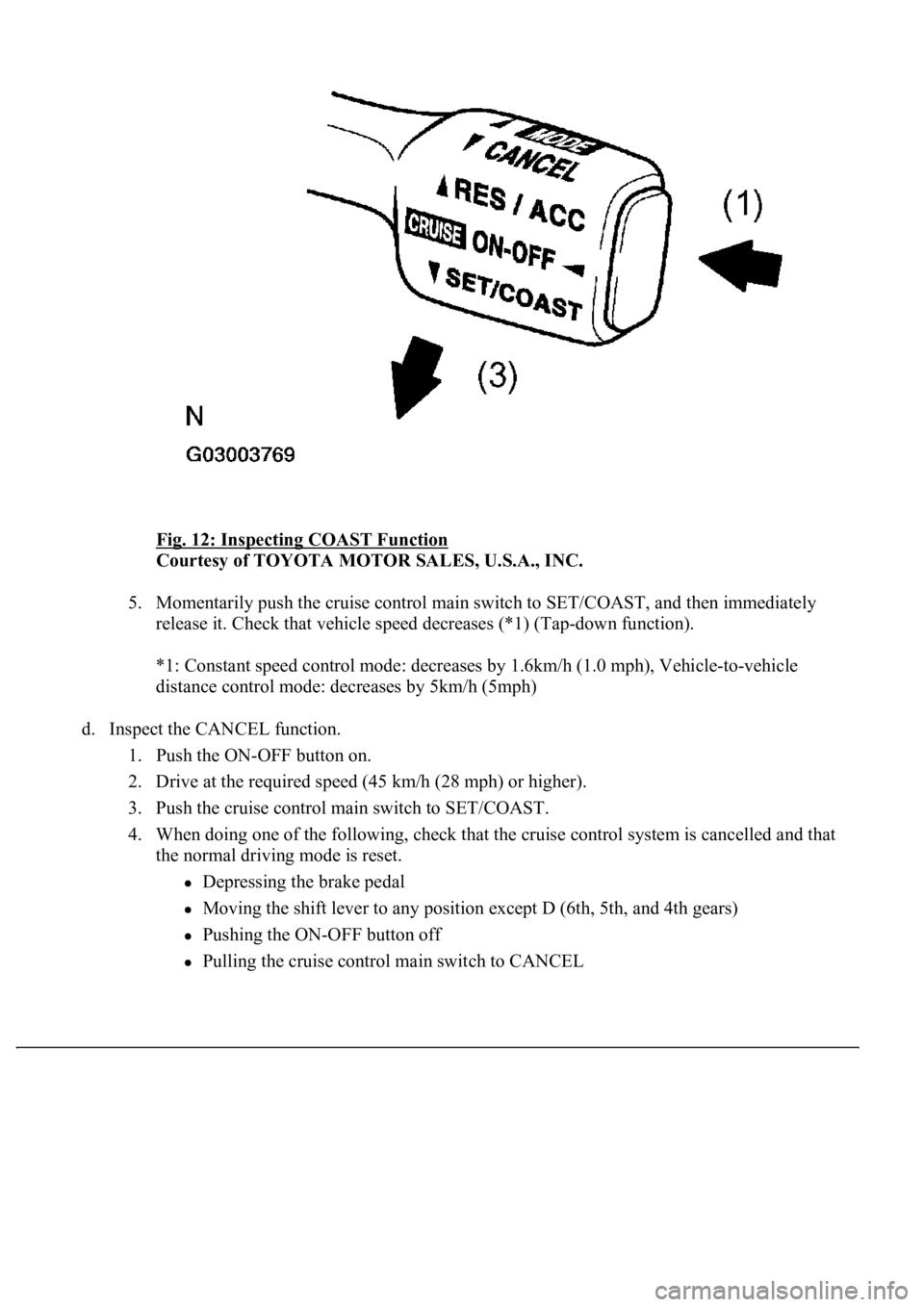
Fig. 12: Inspecting COAST Function
Courtesy of TOYOTA MOTOR SALES, U.S.A., INC.
5. Momentarily push the cruise control main switch to SET/COAST, and then immediately
release it. Check that vehicle speed decreases (*1) (Tap-down function).
*1: Constant speed control mode: decreases by 1.6km/h (1.0 mph), Vehicle-to-vehicle
distance control mode: decreases by 5km/h (5mph)
d. Inspect the CANCEL function.
1. Push the ON-OFF button on.
2. Drive at the required speed (45 km/h (28 mph) or higher).
3. Push the cruise control main switch to SET/COAST.
4. When doing one of the following, check that the cruise control system is cancelled and that
the normal driving mode is reset.
Depressing the brake pedal
<003000520059004c0051004a00030057004b004800030056004b004c004900570003004f0048005900480055000300570052000300440051005c0003005300520056004c0057004c0052005100030048005b0046004800530057000300270003000b001900
57004b000f000300180057004b000f00030044005100470003[4th gears)
Pushing the ON-OFF button off
Pulling the cruise control main switch to CANCEL
Page 2545 of 4500
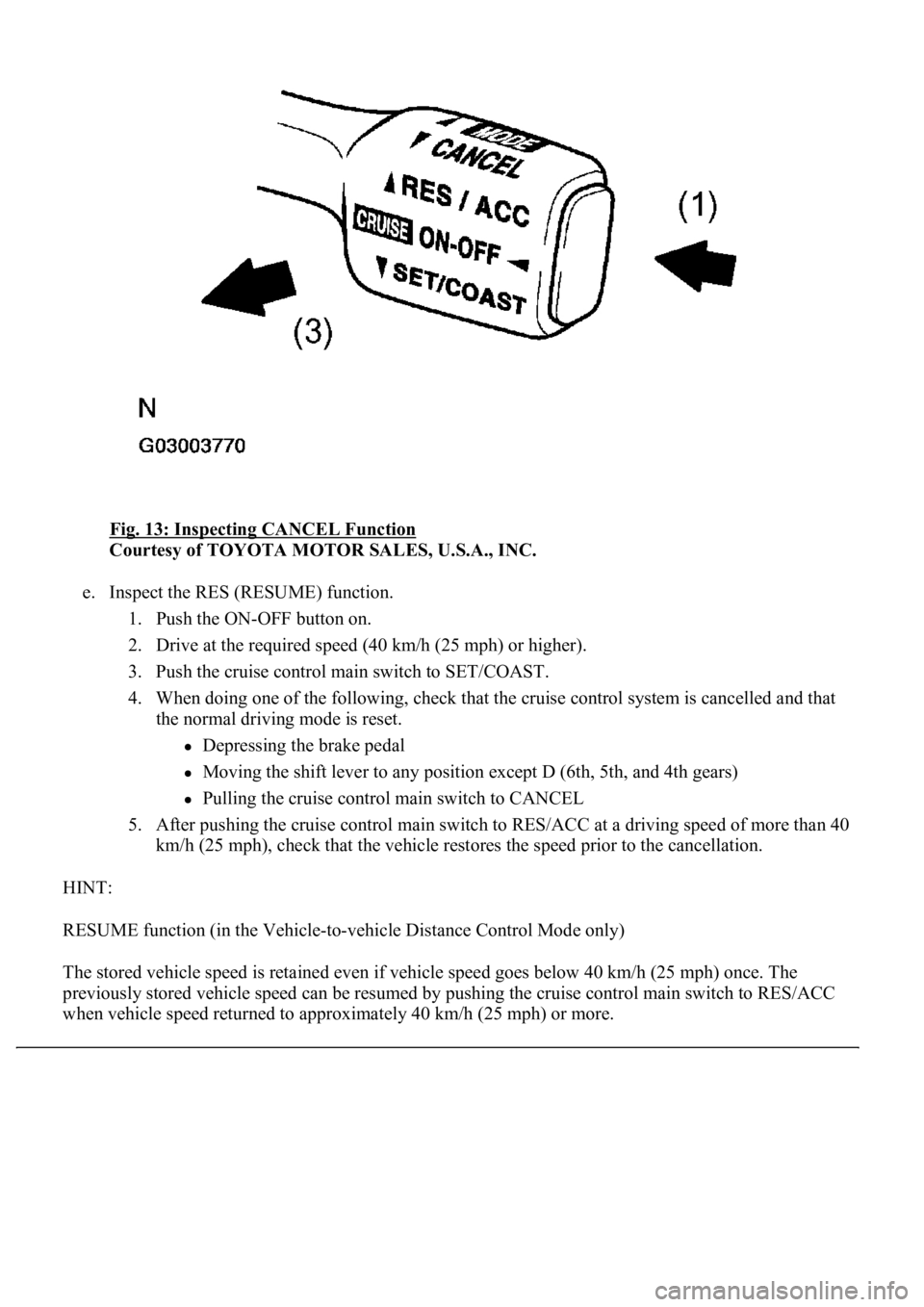
Fig. 13: Inspecting CANCEL Function
Courtesy of TOYOTA MOTOR SALES, U.S.A., INC.
e. Inspect the RES (RESUME) function.
1. Push the ON-OFF button on.
2. Drive at the required speed (40 km/h (25 mph) or higher).
3. Push the cruise control main switch to SET/COAST.
4. When doing one of the following, check that the cruise control system is cancelled and that
the normal driving mode is reset.
Depressing the brake pedal
<003000520059004c0051004a00030057004b004800030056004b004c004900570003004f0048005900480055000300570052000300440051005c0003005300520056004c0057004c0052005100030048005b0046004800530057000300270003000b001900
57004b000f000300180057004b000f00030044005100470003[4th gears)
Pulling the cruise control main switch to CANCEL
5. After pushing the cruise control main switch to RES/ACC at a driving speed of more than 40
km/h (25 mph), check that the vehicle restores the speed prior to the cancellation.
HINT:
RESUME function (in the Vehicle-to-vehicle Distance Control Mode only)
The stored vehicle speed is retained even if vehicle speed goes below 40 km/h (25 mph) once. The
previously stored vehicle speed can be resumed by pushing the cruise control main switch to RES/ACC
when vehicle speed returned to approximately 40 km/h (25 mph) or more.
Page 2686 of 4500
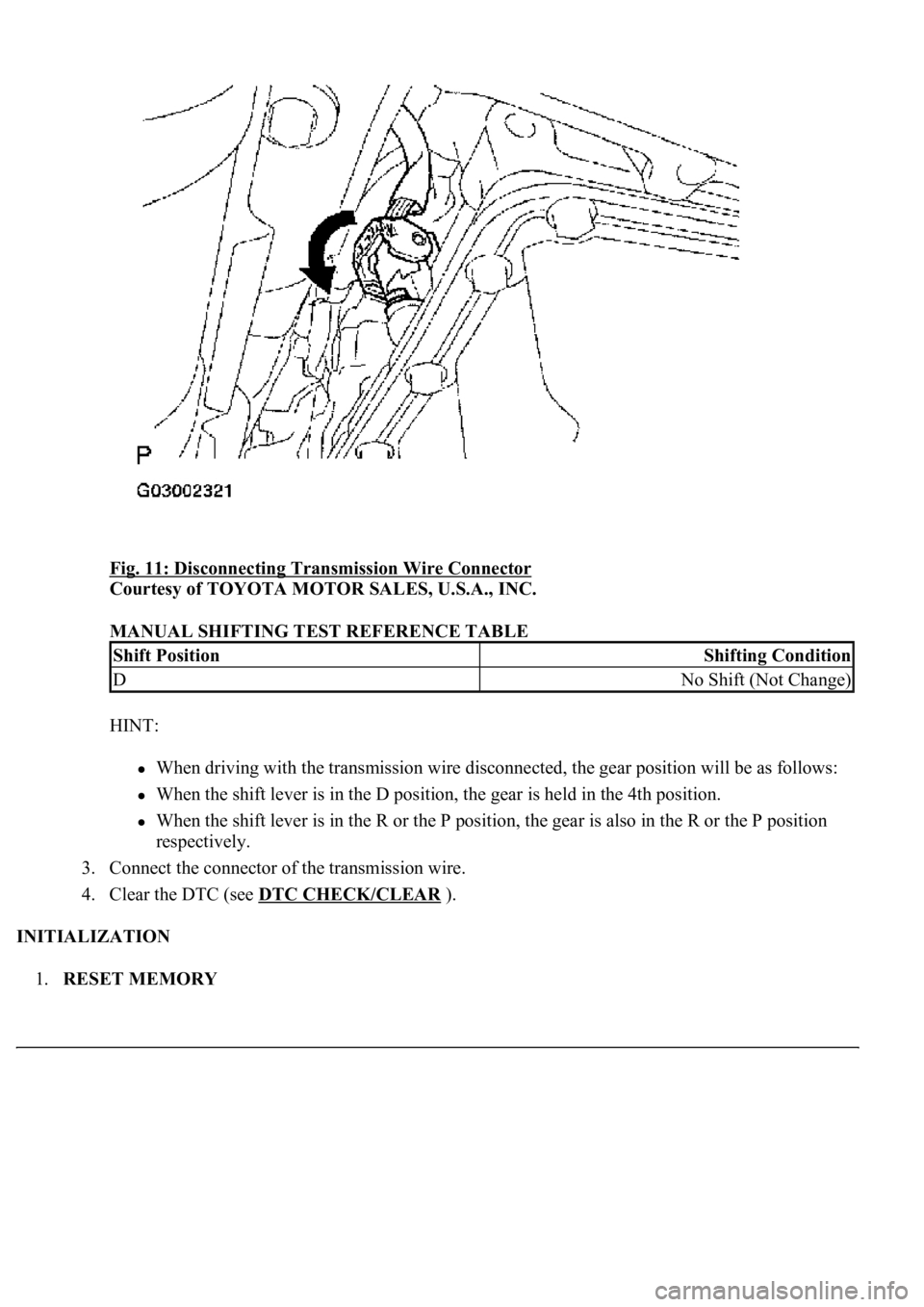
Fig. 11: Disconnecting Transmission Wire Connector
Courtesy of TOYOTA MOTOR SALES, U.S.A., INC.
MANUAL SHIFTING TEST REFERENCE TABLE
HINT:
When driving with the transmission wire disconnected, the gear position will be as follows:
When the shift lever is in the D position, the gear is held in the 4th position.
When the shift lever is in the R or the P position, the gear is also in the R or the P position
respectively.
3. Connect the connector of the transmission wire.
4. Clear the DTC (see DTC CHECK/CLEAR
).
INITIALIZATION
1.RESET MEMORY
Shift PositionShifting Condition
DNo Shift (Not Change)
Page 2687 of 4500
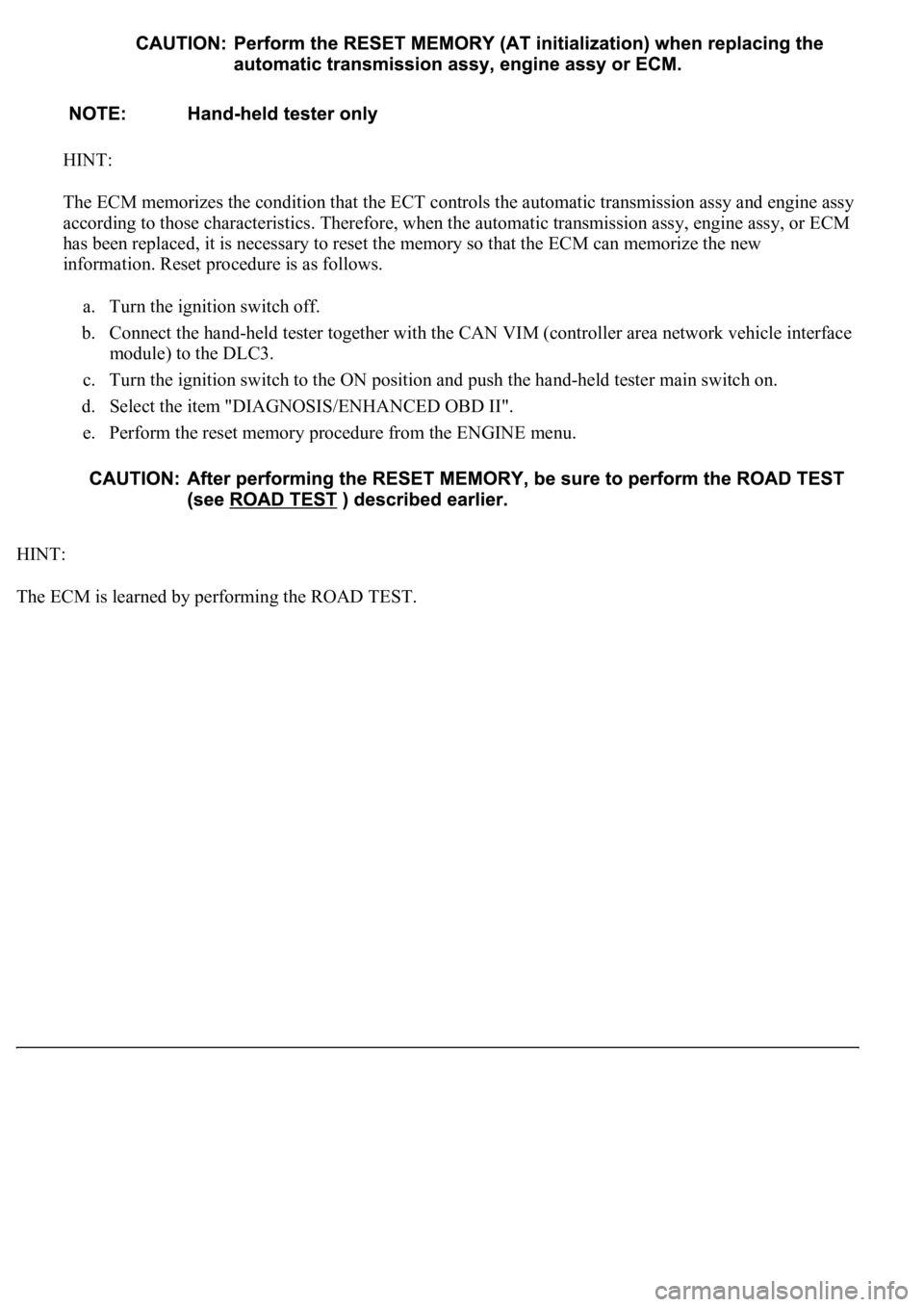
HINT:
The ECM memorizes the condition that the ECT controls the automatic transmission assy and engine assy
according to those characteristics. Therefore, when the automatic transmission assy, engine assy, or ECM
has been replaced, it is necessary to reset the memory so that the ECM can memorize the new
information. Reset procedure is as follows.
a. Turn the ignition switch off.
b. Connect the hand-held tester together with the CAN VIM (controller area network vehicle interface
module) to the DLC3.
c. Turn the ignition switch to the ON position and push the hand-held tester main switch on.
d. Select the item "DIAGNOSIS/ENHANCED OBD II".
e. Perform the reset memory procedure from the ENGINE menu.
HINT:
The ECM is learned b
y performing the ROAD TEST.